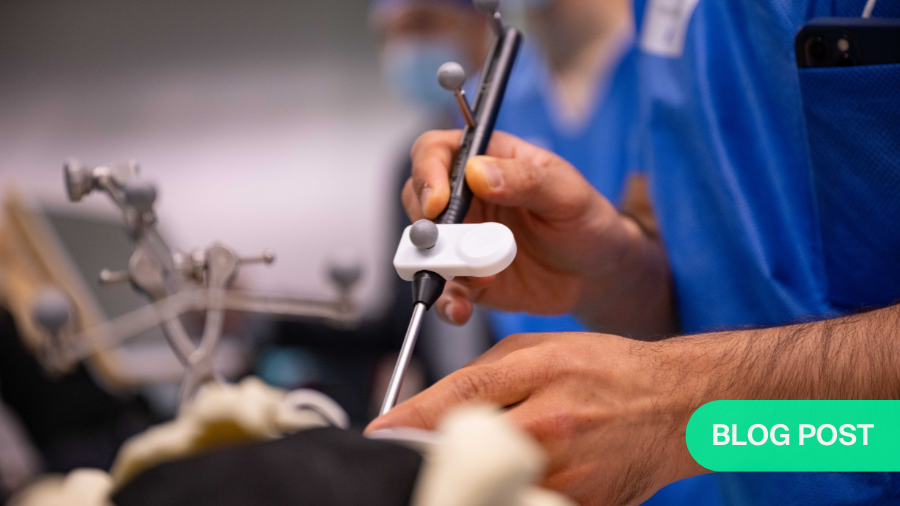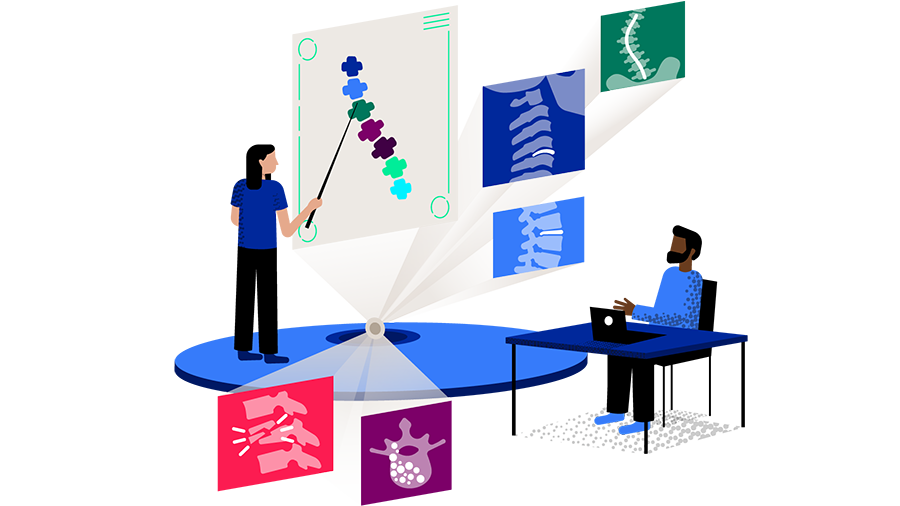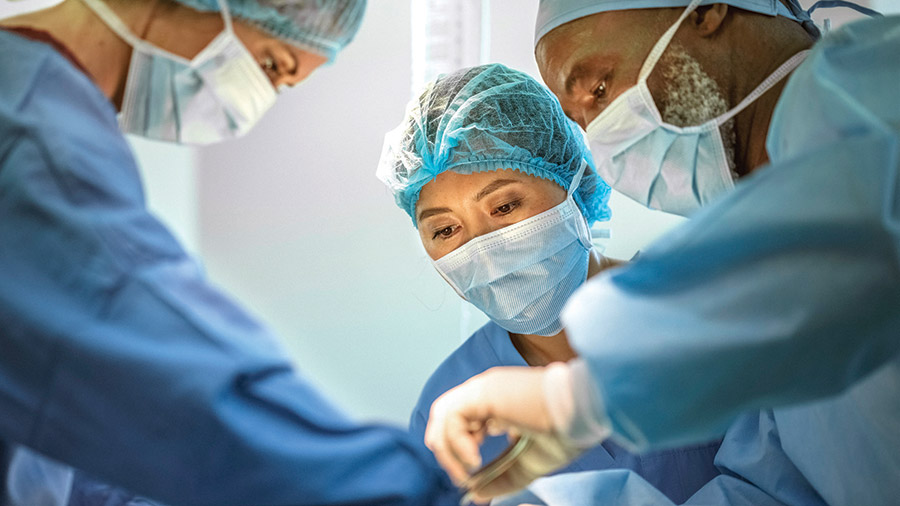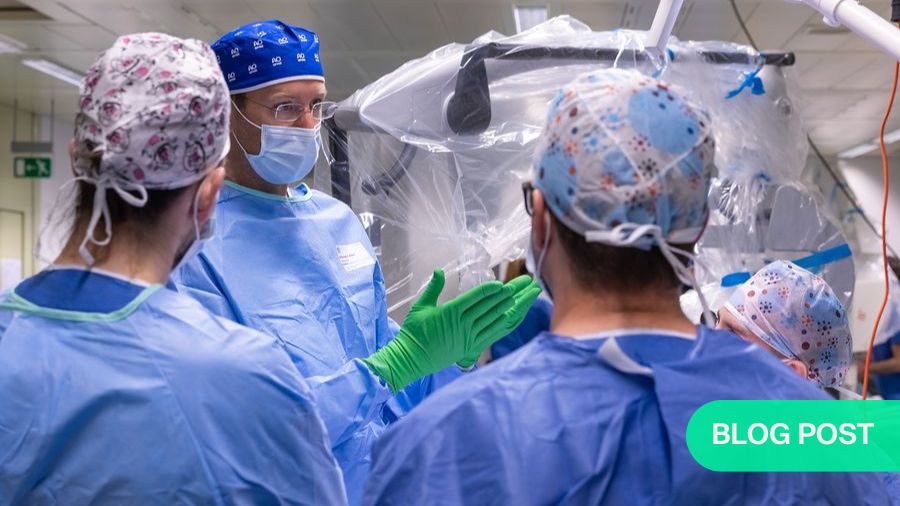Spine instrumentation: between freehand and navigation
BY DR MOHAMED A. ZAAZOUE

A question usually arises: What is the best way to place pedicle screws in spine surgery –– freehand, fluoro-based, or navigation-based? The honest answer is the convenient: It depends. It depends on the context, what this specific patient needs, what the planned approach is, what your comfort level with different approaches is, and what the available resources are, to name a few variables.
Disclaimer: The article represents the opinion of individual authors exclusively and not necessarily the opinion of AO or its clinical specialties.
I completed two neurosurgery residencies, one in a resource-limited setting in Cairo, Egypt. And the other was in what we would consider a resource-abundant setting in Indiana in the United States. Following my second residency, I elected to pursue an orthopedic spine fellowship at a major academic institution in Missouri. I was fortunate that I trained to utilize the different screw placement approaches owing to the protocols, policies and available resources at those institutions.
During my neurosurgery residency in Egypt, the vast majority of cases were done with fluoro-based screw placement. And when technology failed, we placed screws freehand. But C-arm X-ray machines use basic technology so not many chances for it to fail. Also, there were several C-arm machines in the operating rooms. During my neurosurgery residency in the United States, almost all cases were done with navigation-based screw placement. And when technology failed, we placed the screws with fluoro assistance. When this occurred a couple of times during my 7-year residency, the institution elected to purchase a second O-arm machine to be available as a back-up. It also helped serve our increasing clinical volume and allowed multiple operating rooms to use navigation at the same time. During my orthopedic spine fellowship in the United States, all open cases were performed with freehand screw placement. What did we do when technology failed? Well, that’s not a concern.
As one of my mentors said about freehand techniques: “My navigation system is here” (pointing to his head). Obviously, minimally invasive or percutaneous procedures would still be done with fluoro or navigation, usually the latter.
After 7 years of using navigation for virtually all screw placements, I thought I would never “go back” to using freehand. This is particularly important in the current medicolegal environment in the United States, where even a 1 mm sub-optimal placement of a pedicle screw in the lateral recess—medial breach—can lead to a USD 27 million dollar lawsuit.(1) For the record, a medial breach per se does not necessarily mean that the screw is compressing any neural tissue or causing neurological damage. The jury determined that the surgeon was not at fault, and the surgeon and his clinic triumphed at court. The trial took two weeks and there was no guarantee what the outcome of the trial would be.
The increased litigation in the healthcare field in the United States can lead to defensive medicine. Such defensive medicine is one factor behind the increasing healthcare costs in the United States.(2) Afterall, all those capital expenditures on navigation instruments and robots, malpractice insurance costs, attorney fees, lost productivity from attending a two-week trial, etc. must be covered by someone. And it’s usually the end-user, the patient.
It should be noted that even navigated instrumentation can be inaccurate at times, depending on how it is registered and used.
A “1 mm” difference could have been witnessed after a navigated surgery. There are instances during surgery where we check the accuracy of navigation and realize it is off, thus leading us to re-register our navigation parameters. An excellent knowledge of anatomical landmarks, trajectories and freehand techniques would alert the surgeon when something does not feel right. Thus, our training programs should always emphasize the importance of maintaining those freehand skills because, by default, it makes us better minimally-invasive spine surgeons. The tactile feedback of when you are in bone with different instruments, the mental feedback when your navigated trajectory matches your expected trajectory for the screw, and even the auditory feedback from the different sounds produced when the drill is in cortical vs cancellous bone, or when the screw is catching the surrounding cortex as it is being inserted are crucial skills to learn.
In the era of navigation, there is still value in performing surgeries freehand. Perhaps this is the reason why most open spine surgeries at my current institution are performed with freehand techniques.
The surgical procedure is faster and more efficient, allowing the patient to get quickly and safely into and out of the operating room. There is also significantly less exposure to ionizing radiation to the surgical team and more importantly to the patient. There are also the decreased costs associated with freehand techniques. Such capital expenditures can be behind why many healthcare facilities around the world, including in the United States, do not yet possess such technologies. In a study by Striano et al. published in 2024, the authors projected that the lifetime cancer risk from intraoperative CT-based navigation for screw placement in adolescent idiopathic scoliosis is 1 “iatrogenic” malignancy for every 1,000 patients treated. Given how common adolescent idiopathic scoliosis is, this is not an insignificant risk.(3)
I am deeply interested in giving back to my patients who reside within my community in the United States but also patients in resource-strapped parts of the world. Collaborations with spine surgery departments worldwide can allow exchange of experiences and offer surgeons the privilege of contributing to the care of patients worldwide. Some of these patients tend to be at a more advanced stage of their disease and need more complex surgical interventions. If I only rely on navigation for spine surgery, I would be severely limited in the number of patients and parts of the world I can serve and help.
That being said, I believe that minimally invasive surgery and navigation are here to stay. We will keep on pushing the envelope to achieve similar outcomes with less invasive surgery. If we can’t see the anatomical landmarks with our naked eyes (our internal navigation), we must rely on “external” navigation techniques to place the instrumentation. That’s why I decided to seek further advanced training in orthopedic spine surgery at an institution where there is a deep focus on deformity spine surgery and where freehand techniques are the powerhouse of their practice.
I feel that the different phases of my training have prepared me well and put me in a position where I can offer my patients what they “need”, not necessarily what I am “comfortable” doing. Because I believe that the different perspectives I have gained have broadened my horizons and subsequently my “comfort level” with different approaches to the spine. It should be noted that whether a surgeon chooses navigation, a robot, or any other technological advancement for spine instrumentation, these are add-ons to the surgery but do not currently constitute the standard of care.
This post is not intended to say that one approach is better than the other, because both have their pros and cons, and both are beneficial for the right patient and in the right hands. I will continue to perform both approaches and follow the advancements in other aspects of spine surgery to ensure that I am always providing the best care I possibly can to my patients.
On a lighter but very similar note, I learnt to drive on a manual transmission car, with the dreaded “gearshift”. But all the cars I ever owned have been automatic transmission cars. There will always be pros and cons to both types of cars. For instance, one can’t imagine a professional racing driver using a regular automatic transmission car in their races. Ironically, the pedicle finder instrument that some surgeons use in spine surgery for freehand techniques is also called the “gearshift” in operating room slang. I will continue using my “gearshift”, the navigated drill, and even the spine robot depending on the context.
About the author:
Dr Mohamed A. Zaazoue is a neurosurgeon and social entrepreneur. He completed a neurosurgery residency at Indiana University and is currently doing an orthopedic spine fellowship at Washington University in St. Louis, focusing on adult and pediatric deformity. In 2024, he was selected into the American Association of Neurological Surgeons/Congress of Neurological Surgeons Spine Section’s Emerging Investigators program.
Dr Zaazoue is pursuing a career in academic spine surgery. In 2014, he was named on Forbes “30 Under 30” list as one of the most influential social entrepreneurs in the world for his public health advocacy work in Egypt. Between 2014 and 2015, he served as an adviser to the Egyptian President for community development and healthcare reform. His work was also featured in the Financial Times, as part of their Urban Ingenuity awards. In 2015, he moved to the United States with his family to pursue his neurosurgical career. Dr Zaazoue graduated from Ain Shams University School of Medicine in Cairo, Egypt in 2010, where he also completed another neurological surgery residency.
References and further reading:
1. https://www.medscape.com/viewarticle/994826?form=fpf
2. Sethi MK, Obremskey WT, Natividad H, Mir HR, Jahangir AA. Incidence and costs of defensive medicine among orthopedic surgeons in the United States: a national survey study. Am J Orthop (Belle Mead NJ). 2012 Feb;41(2):69-73. PMID: 22482090.
3. Striano BM, Crawford AM, Verhofste BP, Hresko AM, Hedequist DJ, Schoenfeld AJ, Simpson AK. Intraoperative navigation increases the projected lifetime cancer risk in patients undergoing surgery for adolescent idiopathic scoliosis. Spine J. 2024 Jun;24(6):1087-1094. doi: 10.1016/j.spinee.2024.01.007. Epub 2024 Jan 21. PMID: 38262498.
You might also be interested in:
AO Spine fellowships
Providing additional experience in surgical techniques for fully trained orthopedic and neurosurgeons interested in spine surgery.
Skills and career paths for next generation spine surgeons
AO Spine Switzerland leadership reflects on how personal experiences motivated them to launch a novel educational program targeting the young generation of spine surgeons.

Global Spine Diploma
Build, empower, and certify your knowledge at an international level. You will have access to a network of spine professionals around the world and benefit from the experience and support of global leaders in spine surgery.




